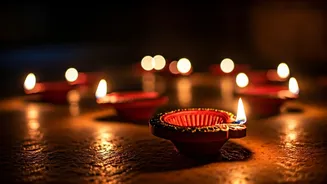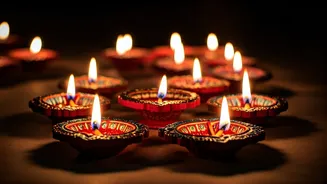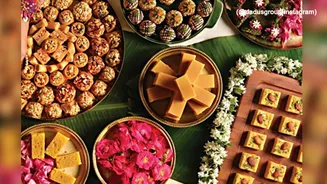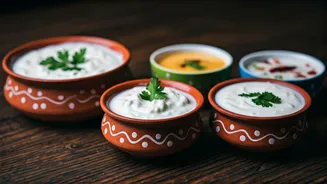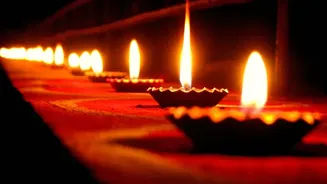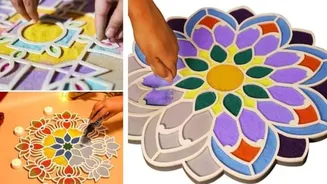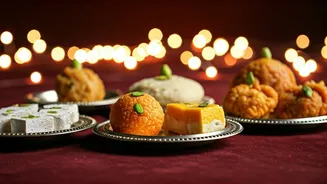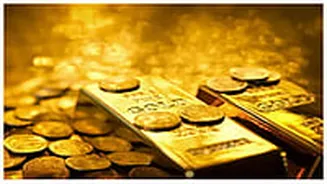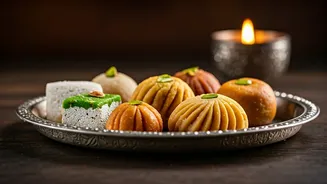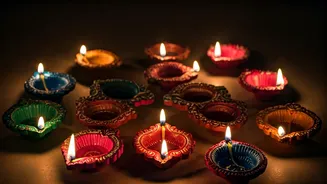Ancient Beginnings
Diwali's origins stretch back thousands of years. It's not just one story, but a tapestry woven from various myths and legends. One popular narrative is
the return of Lord Rama, his wife Sita, and brother Lakshmana to Ayodhya after a 14-year exile. Upon their return, the people of Ayodhya lit up the kingdom with diyas (oil lamps) to welcome them, symbolizing the triumph of good over evil. This victory is remembered and celebrated every year, reminding people that darkness is always dispelled by light. Another account involves the story of Goddess Lakshmi, the goddess of wealth and prosperity, and her association with the festival. In some regions, the festival also commemorates the victory of Lord Krishna over the demon Narakasura. Thus, Diwali is more than one legend; it’s a confluence of belief and history.
Lights and Lamps
The most visible symbol of Diwali is undoubtedly the light. Diyas, traditional oil lamps, are lit and placed throughout homes and outside, creating a beautiful and warm glow. Beyond their aesthetic appeal, diyas are symbolic. They represent the victory of light over darkness and knowledge over ignorance. Different types of lamps are used, from simple clay diyas to more elaborate designs. Besides diyas, candles and electric lights have also become part of the Diwali celebration, especially in modern times. The lighting of lamps is a crucial part of the celebrations, and it adds to the festive atmosphere. People also decorate their homes with colorful lights and lanterns, which further enhance the celebratory mood. Diwali is a festival where the light chases away any darkness.
Rituals and Customs
Diwali is a festival packed with rituals and customs, varying from region to region. Homes are often cleaned, decorated, and sometimes repainted before the festival begins, welcoming Lakshmi into the home. Rangoli, intricate designs made with colored powders, are drawn at the entrance to greet guests. Many families perform special pujas (prayers) to honor Lakshmi, seeking her blessings for wealth and prosperity. The offerings can include sweets, flowers, and incense. Gifts and sweets are exchanged among family members and friends, spreading joy and strengthening bonds. It is customary to burst firecrackers, especially on the night of Diwali, though concerns about air quality have grown. These traditions are not just religious ceremonies but also opportunities to strengthen relationships, renew hope, and celebrate life.
Regional Variations
Diwali celebrations differ greatly across India, reflecting the diversity of culture. In North India, Diwali often celebrates the return of Rama and Sita, with the lighting of lamps and the bursting of fireworks. In West India, especially in Gujarat, the focus is on the goddess Lakshmi and new beginnings. Business people often start new financial years during Diwali. In South India, Diwali might celebrate different stories. Some communities celebrate the victory of Lord Krishna over Narakasura. The celebrations are marked by traditions specific to each region, including special foods and rituals. The way the festival is celebrated is tied to specific regional cultural beliefs. These differences add to the rich fabric of Diwali, making it a unique and unifying festival that is celebrated across the country in various forms.
The Feast of Flavors
Diwali is a foodie's delight, with a wide array of delicious dishes and sweets prepared across India. Each region has its own signature foods and specialties. The sweets often include barfi, ladoo, gulab jamun, and many more, making Diwali a feast for the taste buds. Savory snacks like samosas, and pakoras are also popular. Families come together to prepare these dishes, creating a sense of community and celebration. The aromas of the food add to the festive atmosphere, making Diwali a time to indulge in culinary delights. Sharing food and sweets with loved ones is a significant part of the celebration, representing abundance, togetherness, and happiness. Food is more than just nourishment; it’s a shared experience of joy.
Modern Diwali
Diwali has evolved in the modern era, adapting to the changing times. While the traditional rituals remain, there are also modern elements to it. Diwali is a time when the use of digital technology, like online shopping and social media, is at an all-time high. There is a growing awareness of environmental concerns, with people opting for eco-friendly celebrations, like less use of firecrackers. Diwali is seen as a time for family gatherings and travel, with many people taking a vacation to visit family. The celebration is commercialized, with brands promoting their products and services. Diwali, which once began as a religious event, is now a mix of tradition and modernity, maintaining its spiritual importance while incorporating new ways to mark the holiday. It continues to be celebrated with joy and enthusiasm.
